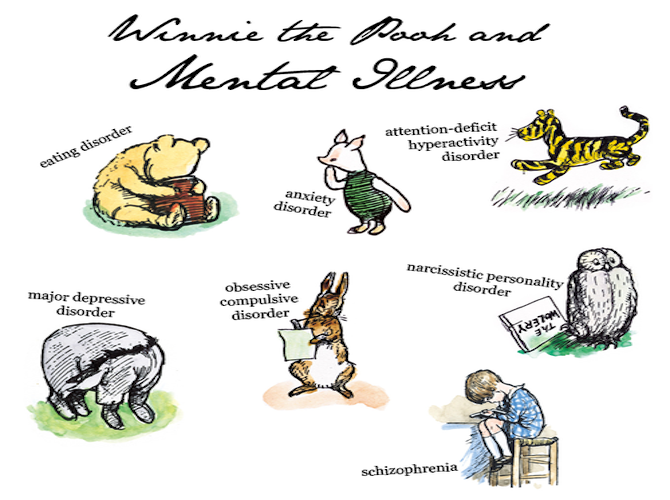Winnie The Pooh & Mental Health: A Surprising Connection?
Could a children's story, beloved for its whimsical charm, hold a mirror to the complexities of mental health? The world of Winnie the Pooh, with its colorful cast of characters, might be more insightful than we initially give it credit for, offering a surprisingly nuanced exploration of psychological conditions.
The Hundred Acre Wood, a haven of innocent adventures, is home to a group of characters whose personalities are as distinct as their appearances. From the honey-loving Pooh to the perpetually gloomy Eeyore, each character embodies unique traits that resonate with viewers of all ages. While the stories themselves don't explicitly address mental health, the behaviors and characteristics of these beloved figures inadvertently mirror real-world psychological patterns. Restlessness, anxiety, sadnessthese emotions are subtly yet powerfully present in the Hundred Acre Wood, inviting us to consider a deeper layer to the narrative.
In 2000, a Canadian Medical Association journal article sparked a conversation, later popularized, suggesting that the characters of Winnie the Pooh could be viewed as representations of various mental health conditions. This perspective, while not a formal diagnostic tool, offers a framework for understanding these conditions through the lens of familiar and beloved characters. It allows individuals, particularly children, to grasp complex issues in a more relatable manner.
Let's delve into the personalities that populate the Hundred Acre Wood and explore how these beloved characters can be viewed in terms of mental health:
| Character | Possible Mental Health Condition(s) | Behavioral Traits |
|---|---|---|
| Winnie the Pooh | Attention-Deficit/Hyperactivity Disorder (ADHD), Eating Disorder | Inattentiveness, disordered thoughts, tendency to forget things, preoccupation with food. |
| Piglet | Generalized Anxiety Disorder, Hypervigilance (possibly stemming from trauma) | Chronic worry, shyness, easily frightened, tendency to overthink. |
| Eeyore | Major Depressive Disorder | Persistent sadness, low energy, pessimistic outlook, social withdrawal. |
| Rabbit | Obsessive-Compulsive Disorder (OCD), Mania | Highly organized, controlling, perfectionistic, prone to manic episodes. |
| Tigger | ADHD, impulsivity | Hyperactivity, impulsiveness, difficulty staying focused, boundless enthusiasm, and seemingly endless energy. |
Reference: Canadian Medical Association Journal Article
The question of whether these portrayals are intentional or coincidental is interesting. A.A. Milne, the author of the Winnie-the-Pooh books, may not have consciously intended to create allegories for mental illnesses. However, his keen observation of human nature and his talent for crafting relatable characters unintentionally provided a lens through which to view psychological complexities.
Consider Pooh, whose love for honey often distracts him from other matters. This could be interpreted as a manifestation of an eating disorder, or possibly even symptoms of ADHD, with his inattentiveness and disordered thoughts. Pooh's calm demeanor and seemingly endless search for honey could be seen as a way of coping with underlying issues. Milne may have been observing behaviors that are common for people who are struggling with mental illness.
Piglet, with his anxious nature and chronic worry, can be seen as a representation of Generalized Anxiety Disorder. His shyness and tendency to overthink, or hypervigilance, may be the result of past trauma, he always seem to be nervous. This aligns with how many people deal with anxiety and worry on a daily basis.
Eeyore, with his consistently gloomy outlook and low energy levels, presents a clear case for Major Depressive Disorder. Eeyore's perspective provides a tangible, relatable framework for understanding depression and its impact on individuals. His constant sadness, social withdrawal, and pessimistic outlook mirror the symptoms often associated with this condition. This interpretation allows readers to empathize with Eeyore's struggles.
Rabbit's meticulous organization and controlling behavior could be indicative of Obsessive-Compulsive Disorder (OCD). The rabbits need to maintain order and control, his perfectionism, and his tendency toward manic episodes could align with the traits of someone managing this condition. Rabbit's behavior, in this context, becomes a poignant illustration of the challenges of living with OCD and mania. Rabbit wants everything according to plan.
Tigger, with his boundless energy and impulsiveness, might be considered to exhibit signs of ADHD. Tigger's constant movement and enthusiasm, combined with his tendency to act without thinking, serve as examples of impulsivity and hyperactivity.
The portrayal of mental illness in children's literature is not uncommon, though it isn't always explicitly labeled. By using familiar characters such as those from Winnie the Pooh, it helps facilitate a more accessible way to discuss complex conditions like these with children. The stories provide clear metaphors for how these mental issues are displayed.
The use of familiar characters to represent mental health conditions helps to remove the stigma associated with mental illness. Children and adults alike are able to relate to the characters, which allows for an open discussion about the various mental health issues. It creates an environment where it is safe to talk about mental health.
It is crucial to remember that these are interpretations and not formal diagnoses. However, the framework helps us to recognize mental health patterns. Winnie the Pooh is not a diagnostic tool, but a lens through which we can explore the human condition. It's a valuable tool for increasing awareness and for encouraging those struggling with depression, anxiety, or other mental health conditions to seek help. By identifying similar symptoms in ourselves or others, we can create a supportive environment for mental well-being.
The enduring appeal of Winnie the Pooh lies in its ability to connect with readers of all ages. The Hundred Acre Wood is a place of comfort, where characters embrace their imperfections and celebrate their differences. It is possible that the characters, with their diverse behaviors, are reflections of real-world mental health conditions. The stories also invite us to think about our own behavior patterns, allowing us to recognize traits that resonate with us.
These stories serve as an important conversation starter. It is possible to open up lines of communication and promote understanding. The use of these characters allows for open discussions about mental health in a comfortable way, because everyone knows these characters. By identifying the signs and symptoms in familiar characters, everyone can start conversations and, hopefully, seek help when needed.
Whether intentional or not, Winnie the Pooh, and his peculiar friends are unexpected guides, leading us through the complex landscapes of mental health. It is possible that these tales are not only heart-warming stories but also lessons in empathy, resilience, and understanding. They teach us that it is okay to feel, and to seek help when needed.


